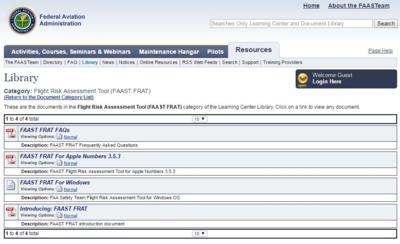Wed, Dec 21, 2016
Explaining The Flight Risk Assessment Tool
Flying safely and preventing Loss of Control (LOC) accidents is the responsibility of every pilot, of course, and there are tools available that can make it easier for pilots to assure they arrive safely at their destinations.

One of those is a FRAT, or Flight Risk Assessment Tool.
FRAT is an acronym for a handy tool that will earn your respect through its ability to help keep you safe. A FRAT helps you to identify the risk profile as you plan a flight. Factors such as type of operation, environment, aircraft, crew training, and overall operating experience are evaluated by the tool. This helps you determine if the flight falls in a low, medium, or high-risk category. More importantly, after seeing the data, you can develop risk mitigation strategies to ensure your safety as well as the safety of your passengers.
The General Aviation Joint Steering Committee (GAJSC), a government/industry group that analyzes GA accidents and incidents, has found that improved risk assessment before and during a flight can significantly improve your chances of avoiding accidents and incidents. Although a FRAT tool cannot anticipate ALL hazards, it can help you recognize and mitigate the most common ones.
The FAA FAAST Team has developed simple, automated spreadsheets that run on Microsoft Windows or Apple operating systems. All you have to do is download the file at http://go.usa.gov/xkhJK. There are also many free FRAT apps available for your mobile device. The FAA hopes to roll out its own FRAT app in the near future.
The FRAT format is pretty basic: In the FAA version, VFR pilots will consider which of the 20 flight, pilot, and aircraft conditions apply to the upcoming flight. IFR pilots have 22 conditions to review. Each condition is assigned a numerical value. Simply click the YES box next to each condition that applies to your flight. When you are finished, the total value corresponds to a risk matrix chart. If you are uncomfortable with the level of risk identified, mitigate the risk by adjusting conditions to improve your chances for a safe flight.
When you begin to use a FRAT, you’ll probably think of additional potential hazards. That’s to be expected and we encourage it because it means you are taking an active role in your Safety Risk Management. Think of each hazard as a potential liability. When you offset those liabilities with assets – good decisions – you will reduce or eliminate hazards and keep your safety account in balance.
A Loss of Control (LOC) accident involves an unintended departure of an aircraft from controlled flight. LOC can happen because the aircraft enters a flight regime that is outside its normal flight envelope and may quickly develop into a stall or spin. It can introduce an element of surprise for the pilot.
Contributing factors may include:
- Poor judgment or aeronautical decision making
- Failure to recognize an aerodynamic stall or spin and execute corrective action
- Intentional failure to comply with regulations
- Failure to maintain airspeed
- Failure to follow procedure
- Pilot inexperience and proficiency
- Use of prohibited or over-the-counter drugs, illegal drugs, or alcohol
"The FAA and industry are working together to prevent LOC accidents and save lives. You can help make a difference by joining our Fly Safe campaign," said FAA administrator Michael Huerta. "Each month on FAA.gov, we’re providing pilots with a LOC solution developed by a team of experts. They have studied the data and developed solutions – some of which are already reducing risk. We hope you will join us in this effort and spread the word. Follow #FlySafe on Twitter, Facebook and Instagram. I know that we can reduce these accidents by working together as a community."
(Source: FAA. Image from file)
More News
Also: B-29 Superfortress Reunion, FAA Wants Controllers, Spirit Airlines Pulls Back, Gogo Galileo Van's Aircraft posted a short video recapping the goings-on around their reorganiz>[...]
Light Gun A handheld directional light signaling device which emits a brilliant narrow beam of white, green, or red light as selected by the tower controller. The color and type of>[...]
"The journey to this achievement started nearly a decade ago when a freshly commissioned Gentry, driven by a fascination with new technologies and a desire to contribute significan>[...]
"Our driven and innovative team of military and civilian Airmen delivers combat power daily, ensuring our nation is ready today and tomorrow." Source: General Duke Richardson, AFMC>[...]
Aircraft Conflict Predicted conflict, within EDST of two aircraft, or between aircraft and airspace. A Red alert is used for conflicts when the predicted minimum separation is 5 na>[...]
 Airborne 04.16.24: RV Update, Affordable Flying Expo, Diamond Lil
Airborne 04.16.24: RV Update, Affordable Flying Expo, Diamond Lil ANN's Daily Aero-Term (04.20.24): Light Gun
ANN's Daily Aero-Term (04.20.24): Light Gun Aero-News: Quote of the Day (04.20.24)
Aero-News: Quote of the Day (04.20.24) Aero-News: Quote of the Day (04.21.24)
Aero-News: Quote of the Day (04.21.24) ANN's Daily Aero-Term (04.21.24): Aircraft Conflict
ANN's Daily Aero-Term (04.21.24): Aircraft Conflict



